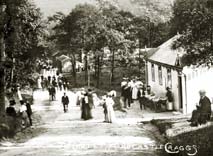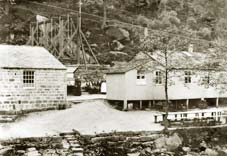|
Home Subscriptions Send us your memories Buy online Links ISSUE 4 CONTENTS From "Prison" to Pleasure Palace |
From "Prison" to Gibson Mill and its special place in the Crags Compiled by Issy Shannon and Diana Monahan Gibson Mill wasn't the worst, by any means, of the many hundreds of factory "prisons" that sprang up in the 19th century. Lord Holme Mill - to give it its official title - was erected in the early 1800s by Abraham Gibson, a Heptonstall farmer and cotton spinner, of Greenwood Lee. Following his death in 1790, it was his son, another Abraham, who set in motion the changes which were to transform the family's cottage industry into a much more ambitious concern; a factory was erected in the heart of Hardcastle Crags and manufacturing began in earnest. Gibson Mill at the height of its popularity in the 1920s. The family line was to survive for only four generations, however. Abraham the second was succeeded by his younger son, William, who in turn produced yet another Abraham, nicknamed "Young Ab," whose death, in 1956, brought the Gibson dynasty to an end. But his legacy was to have far-reaching effects on the area, for it was Young Ab, who not only left a considerable sum of money to local good causes, but, perhaps more significantly, willed his Hardcastle Crags acres to the National Trust. These linked up with land given to the Trust by Lord Savile in 1948 and Henry Mitchell Ingham in 1950, opening the entire valley to the public. Around 1900 the former cotton mill, a grim monument to slavery and hard labour, was transformed into the Lord Holme Restaurant boasting skating, dancing and catering with accommodation for 600. The former weaving shed - "where there were handy pillars down the centre of the room to support the less skilful" - became the setting for roller skating; there were dances, a fun fair and numerous tea rooms scattered around the hillsides. But the blood of his forefathers ran strongly in Young Ab and he was not slow to spot a new opportunity when he saw one. Utilising the mill's original fuel, water, he had turbines installed in the old wheelhouse to power electricity at his home, the supply carried by cables up the hillside. Not one to deny others the joys of modern living, electricity was also laid on to cottages rented out to holiday-makers. There was, however, a downside to Young Ab's philanthropy: rumour had it that the master switch was at Greenwood Lee and on retiring at night the owner always made sure it was turned off! Our thanks to Peter Thomas, author and publisher of "Mill, Murder and Railway," for his help in compiling this article. As well as a full and detailed account of Gibson Mill Peter's excellent book also includes chapters on the Hawden Hole Murder" and the railway at Walshaw Dean. "Mill, Murder and Railway" is available from retail outlets throughout the Upper Calder Valley. It must have been a
special occasion to draw such big crowds. The Crags, thronged with visitors,
around the turn of the last century.
Mitchell's Pavillion
circa 1910, with the famous swing boats in the background. This photo has
only recently come to light. Read the full story in Milltown Memories, issue 4. If this or other stories stirs a memory, we'd be happy to know - send us your memories and comments. |



